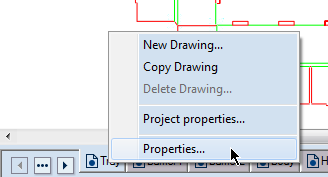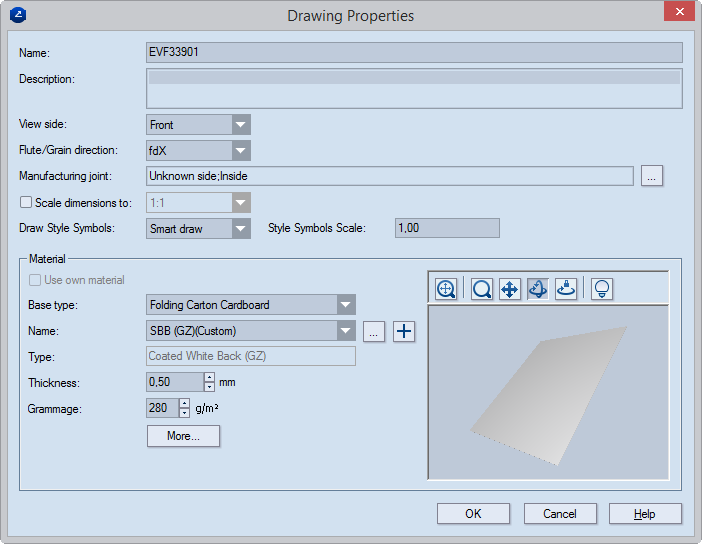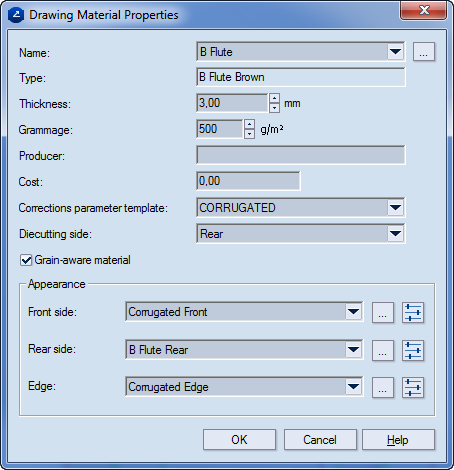 Click to select or reset the structure's manufacturing joints.
Click to select or reset the structure's manufacturing joints.You can set overall properties for an individual drawing regarding the material, its type and appearance.
To set drawing properties

The Drawing Properties dialog box appears.

Name Sets the name of the drawing.
Description (optional) A space for notes describing the drawing.
View side Sets the design side that will be displayed in the graphical area.
Flute/grain direction Sets the direction — along the x- or the y-axis — of the flute (or grain) of the material.
Glue/Stitching Loads the manufacturing joint preset for the structure, if such a property is set for the structure.
 Click to select or reset the structure's manufacturing joints.
Click to select or reset the structure's manufacturing joints.
USAGE NOTE: Set a manufacturing joint if (1) Prinect is integrated with an external production system that requires information about the joint or (2) you want to create an editable source structure; by editing the manufacturing joint, you use the structure to which it is applied to effectively construct a different design.
Scale dimensions to (Not selected by default) Sets how EngViewPrinect will scale dimensions while exporting or printing out the drawing. The options are 1:1 (WYSIWYG) or a custom pattern. If you need a different pattern, select the check box, and then define a custom scaling pattern.
Draw Style SymbolsSets how style symbols will appear on the screen in the drawing.
Style Symbols Scale Sets a scale factor that the program will apply for reproducing style symbols on the screen, on print and exported drawings. Example: If a style symbol is 16x16 pixels and the scale factor is 2.00, the symbol size will be displayed twice as large on the screen.
Material Settings for the material used for the design in the drawing.
Use own material Overrides the material set for the whole project and allows the use of another one for the current drawing.
NOTE: If the check box is unavailable, this means that a certain material has already been set for the whole project. If you want to change the material of specific drawings, (1) enable the use of different materials in the project, and then (2) select the check box and set a new material for the current drawing.
Base type Sets on which material type the current material will be based.
Name Sets the material for the project. To select a different material, click the browse button  , and then, in the dialog box that appears, select a material.
, and then, in the dialog box that appears, select a material.
 Opens a dialog box in which you can add a material to the catalog.
Opens a dialog box in which you can add a material to the catalog.
Type Displays the subtype on which the material is based (read-only).
Thickness Sets a thickness of the material.
Grammage Sets the material's weight in g/m2.
More Opens a dialog box in which specific properties can be added for the drawing (see Step 3).
The Drawing Material Properties dialog box appears.

Name Sets the name of the material.
Type Displays the base material type that the material is based on (read-only).
Thickness Sets the distance between the two surfaces of the sheet.
Grammage Sets weight, in g/m2, for the material.
Producer Sets the producer.
Cost Sets a cost for the material.
Corrections parameters template Applies a parameter template that will apply for the operations in which the material is used.
Diecutting side Indicates the side on which the die will fall.
Grain-aware material Indicates the direction of the fiber in the material's texture.
Appearance (In the dropdowns, to select a different appearance, click the browsing button  , and then, in the Material Surface Appearances dialog box, select a material.)
, and then, in the Material Surface Appearances dialog box, select a material.)
Front side Sets a material appearance for the front side.
Rear side Sets a material appearance for the rear side.
Edge Sets a material appearance for the edge.